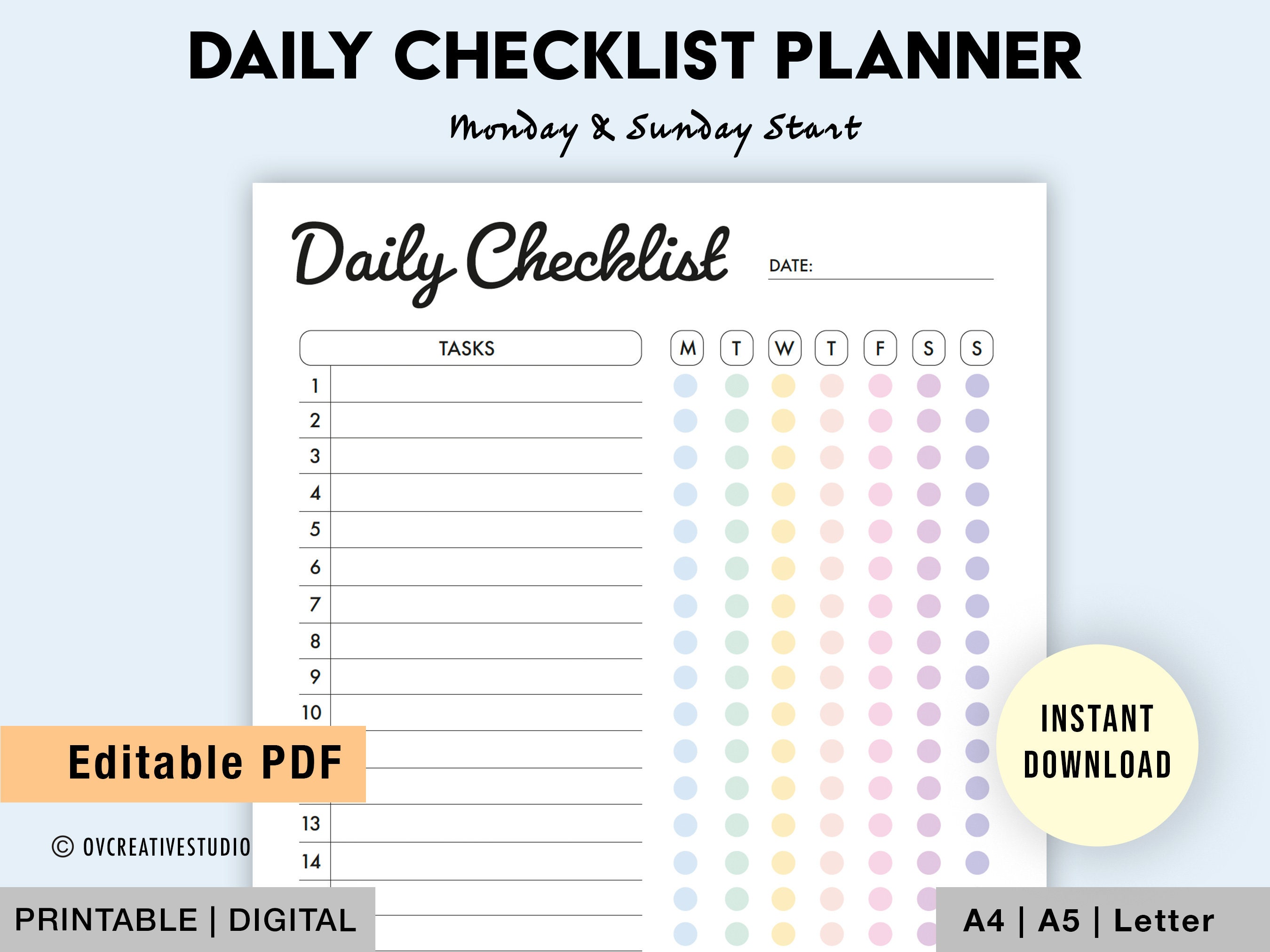
Okay, here’s a comprehensive article on creating a daily money goals checklist, targeting a word count of approximately 1200 words.
Daily Money Goals Checklist: Your Blueprint for Financial Success
In the pursuit of financial stability and wealth creation, it’s easy to get lost in grand plans and long-term strategies. While those are undoubtedly important, they can often feel overwhelming and distant, leading to procrastination and a lack of tangible progress. That’s where the power of daily money goals comes in. By breaking down your financial objectives into manageable, bite-sized tasks, you create a framework for consistent action and build momentum towards your overall financial dreams. A daily money goals checklist is your roadmap to making those dreams a reality, one intentional step at a time.
Why Daily Money Goals Matter
Before diving into creating your checklist, let’s explore why focusing on daily financial actions is so effective:
- Reduced Overwhelm: Large financial goals like paying off debt or saving for retirement can feel daunting. Daily tasks break them down into manageable steps, making them less intimidating and more achievable.
- Increased Awareness: Regularly engaging with your finances through a checklist forces you to be more mindful of your spending habits and income streams. This heightened awareness is crucial for making informed financial decisions.
- Improved Consistency: Daily repetition fosters consistency, a key ingredient for long-term financial success. Small, consistent actions compound over time, leading to significant results.
- Enhanced Motivation: Checking off items on your daily checklist provides a sense of accomplishment and motivates you to continue making progress. This positive reinforcement loop helps you stay on track.
- Behavioral Change: By consciously making financial decisions each day, you’re actively shaping your financial behavior. This can lead to breaking bad habits and adopting more positive financial practices.
- Proactive Approach: Instead of passively reacting to financial situations, a daily checklist encourages a proactive approach to managing your money. You’re taking control of your finances rather than letting them control you.
Crafting Your Daily Money Goals Checklist: A Step-by-Step Guide
Creating an effective daily money goals checklist requires careful consideration and personalization. Here’s a step-by-step guide to help you build a checklist that aligns with your specific financial goals and lifestyle:
1. Define Your Overall Financial Goals:
Before you can create daily tasks, you need a clear understanding of your overarching financial goals. Ask yourself:
- What do you want to achieve financially in the short-term (1-3 years), medium-term (3-5 years), and long-term (5+ years)?
- Do you want to pay off debt, save for a down payment, invest for retirement, or achieve financial independence?
- How much money do you need to achieve each of these goals?
Write down your goals clearly and specifically. For example, instead of "save more money," aim for "save $500 per month for a down payment on a house."
2. Break Down Goals into Actionable Tasks:
Once you have your overall goals, break them down into smaller, actionable daily tasks. Think about the specific steps you can take each day to move closer to your objectives. Here are some examples:
- Debt Payoff:
- Track spending to identify areas for reduction.
- Prepare and eat meals at home instead of eating out.
- Make an extra payment of $X towards your highest-interest debt.
- Research balance transfer options to lower interest rates.
- Saving for a Down Payment:
- Transfer $X from your checking account to your savings account.
- Automate a daily or weekly transfer to your savings.
- Research potential investment options for your down payment fund (considering your risk tolerance and time horizon).
- Investing for Retirement:
- Contribute to your 401(k) or IRA.
- Research and select a low-cost index fund or ETF.
- Rebalance your investment portfolio.
- Read a financial article or book to expand your knowledge.
- Budgeting and Expense Tracking:
- Log all your expenses for the day.
- Review your budget and identify areas where you can cut back.
- Plan your meals for the week to avoid impulse purchases.
3. Create Your Checklist Template:
Choose a format that works best for you. You can use:
- A physical notebook or planner: This is a great option if you prefer to write things down.
- A spreadsheet: Excel or Google Sheets allows for easy tracking and analysis.
- A task management app: Apps like Todoist, Asana, or TickTick can help you organize and track your tasks.
- A budgeting app: Many budgeting apps have features that allow you to set daily financial goals and track your progress.
4. Sample Daily Money Goals Checklist:
Here’s a sample checklist to get you started. Remember to customize it to fit your own goals and circumstances:
- [ ] Track all expenses (using a budgeting app or spreadsheet).
- [ ] Review your budget and compare it to your actual spending.
- [ ] Make coffee at home instead of buying it.
- [ ] Transfer $X to your savings account.
- [ ] Make an extra debt payment of $X.
- [ ] Read one article about personal finance.
- [ ] Plan your meals for tomorrow to avoid eating out.
- [ ] Check your bank accounts and credit card statements for fraudulent activity.
- [ ] Look for ways to reduce expenses on subscriptions or recurring bills.
- [ ] Sell an unused item online.
5. Tailoring the Checklist to Your Personality & Schedule:
- Be Realistic: Don’t overload your checklist with too many tasks. Start with a few key items and gradually add more as you get into the habit.
- Prioritize Tasks: Focus on the tasks that will have the biggest impact on your financial goals.
- Adapt to Your Schedule: Consider your daily routine and schedule your tasks accordingly. If you’re a morning person, tackle your most important tasks first thing in the morning.
- Make it Enjoyable: Include tasks that you find rewarding or motivating. For example, if you enjoy reading, make it a goal to read a personal finance book for 15 minutes each day.
6. Review and Adjust Regularly:
Your daily money goals checklist is not set in stone. Review it regularly (weekly or monthly) and make adjustments as needed.
- Are you consistently completing all the tasks on your checklist? If so, consider adding more challenging tasks.
- Are you struggling to complete certain tasks? Simplify them or break them down into smaller steps.
- Are your goals still relevant? As your financial situation changes, you may need to adjust your goals and your checklist accordingly.
Tips for Sticking to Your Daily Money Goals Checklist
- Make it a Habit: The key to success is to make your checklist a part of your daily routine. Set a reminder on your phone or calendar to review your checklist each day.
- Find an Accountability Partner: Share your checklist with a friend or family member and ask them to check in on your progress.
- Reward Yourself: Celebrate your successes, both big and small. When you reach a milestone, treat yourself to something you enjoy (within your budget, of course).
- Don’t Get Discouraged: Everyone has setbacks from time to time. If you miss a day or two, don’t give up. Just get back on track as soon as possible.
- Visualize Success: Spend a few minutes each day visualizing yourself achieving your financial goals. This can help you stay motivated and focused.
Conclusion
A daily money goals checklist is a powerful tool for achieving financial success. By breaking down your goals into manageable tasks, you can create a framework for consistent action and build momentum towards your dreams. Remember to tailor your checklist to your specific goals, lifestyle, and personality. Review and adjust it regularly to ensure that it remains relevant and effective. With consistent effort and dedication, you can use your daily money goals checklist to transform your financial life. The power to change your financial future is in your hands, one intentional daily action at a time.



